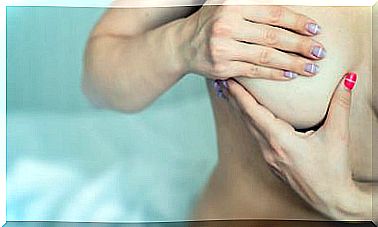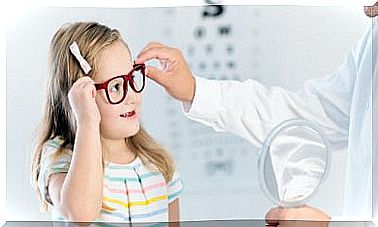Inverted Nipple: Causes And When To Visit The Doctor
The inverted nipple is one of the abnormalities that can affect the breasts. It is a condition with a significant aesthetic impact, but it can also negatively influence breastfeeding.
This pathology can be present from birth or develop throughout life. When this happens, a carcinogenic process should not be ruled out immediately. Therefore, in this article we explain everything you need to know about the inverted nipple and how to identify it.
What is the inverted nipple?
The nipple is a small lump found on the breasts, both in men and women. It is surrounded by the areola, which is a kind of circle of slightly pigmented and sensitive skin.
It is the area through which the ducts of the mammary gland contact the outside. Its main function is breastfeeding. In most people, the nipple is one centimeter long and one centimeter in diameter and is located in the center of the breast, bulging outward.
Nipple abnormalities are fairly common defects. The inverted nipple is one of them. It consists in that , instead of protruding outwards, it looks into the breast, leaving a kind of concavity.
According to an article published in the Journal of Plastic Surgery, it can be congenital or acquired. Acquired cases have a higher prevalence, affecting between 2% and 10% of the general population.

What symptoms does this pathology produce?
The symptoms of the inverted nipple depend, in large part, on what is its cause. When the defect is congenital and appears from birth, it is usually somewhat benign. In fact, it is not usually accompanied by any other symptoms beyond the aesthetic repercussions.
However, we must bear in mind that this type of malformation has a strong impact on self-esteem. In the case of a congenital inverted nipple, most women begin to worry about puberty. It is when the breasts develop and the defect becomes more evident.
When the inverted nipple is acquired and develops abruptly, symptoms usually appear depending on the underlying pathology. In addition, in this case only one of the nipples is affected, unlike in those of congenital cause.
For example, it can present with chest pain or general discomfort. Similarly, when the breast is palpated, it is common to find a lump or mass. The skin tends to be thickened, red, and irritated. In some cases there may be some discharge as well.
On the other hand, it is important to differentiate between the inverted nipple and the retraction. The retraction consists in that the areola also sags.
When to see a doctor
Any abnormality in the breasts should be consulted with the doctor quickly. This is because some of them may be related to breast cancer, so seeking care should not be delayed.
In the case of the inverted nipple, as it is a defect that appears abruptly at times, it is essential to go to the professional. In many cases, the inversion takes months, but patients realize when they have gone a long way.
Therefore, it is essential that, especially women, pay attention to their breasts. It is recommended that each woman self-examine her breasts frequently. To do this, you must palpate each quadrant and try to observe any abnormal signs or discomfort.
Causes of inverted nipple
As we have explained, the inverted nipple can be congenital or acquired. Congenital is caused by fibrous bands in the breast tissue that prevent the nipple from developing normally. In this way they pull it, preventing it from protruding outside.
Acquired cases are more frequent. It can be the consequence of a benign and physiological process or of a disease. For example, there are people who develop this defect with aging.
Another major cause, according to Synergy Medical Journal is mastitis. It consists of the inflammation of the breast tissue that can be associated with an infection of the same. In many cases it is related to breastfeeding. In addition, in cases of infection there may be fever and general malaise.
Another cause of inverted nipple is ectasia of the mammary duct. According to the Mayo Clinic, this pathology does not have to cause symptoms, but it is also associated with this defect.
Breast duct ectasia is that one of the milk ducts widens and its walls thicken. It fills with fluid that, little by little, thickens and ends up obstructing the area, with consequent inflammation.
Other causes of inverted nipple
The inverted nipple can be a symptom of different types of cancer. First, it is related to Paget’s disease. It is a rare form of breast cancer that appears in women over 50 years of age. In addition, it is more common in those who already have ductal breast cancer.
Breast carcinoma is one of the most common causes of acquired inverted nipple. Most of the mammary tumors originate in the ducts of the gland. In fact, according to the GEICAM Breast Cancer Research Group, one in eight women will develop this disease at some point in her life.
How is it diagnosed?
The inverted nipple can be seen with the naked eye. However, to know what is its cause it is important to perform a complete physical examination and to know the entire history of the patient.
In addition, there are different complementary tests that are very useful to rule out other pathologies. In the first place, the most used are mammography and ultrasound. They allow you to see the internal structure of the breast.
If an abnormal mass is seen in these tests, a biopsy may be necessary. For this, a needle is used, through which a sample of the gland tissue is obtained. It is then analyzed under a microscope to check for tissue abnormalities.

Can the inverted nipple be treated?
As we have mentioned, the inverted nipple is a defect that has a great impact on self-esteem. In addition, in many cases it is the consequence of a serious pathology. Therefore, it is indicated to treat it and there are different ways to do it.
To choose the best treatment, this pathology is classified according to its severity. Mild cases can be corrected with manipulation, although they tend to recur. The most serious usually require surgery.
When we talk about manipulation, we refer to different techniques that allow the nipple to be repositioned without the need for surgical intervention. For example, the Hoffman exercises. They consist of taking the nipple and stretching it out for a few seconds, several times a day.
Another possibility is the training shields. They are structures that adapt to the areola, with a small hole in the center for the nipple. What they do is stimulate it to protrude outward again.
Inverted nipple surgery
Surgery can be aimed both at eliminating the original cause of this defect and at its own reconstruction. In the latter case, it is a simple operation that can be carried out with local anesthesia. An incision is made at the base of the nipple and pulled .
In this way, the nipple is repositioned in its natural position, suturing it to fix it. However, there are more and more techniques to perform this procedure. For example, in an article published in Ibero-Latin American Plastic Surgery they compare novel options.
If you have an inverted nipple, see
It is important that, if this defect appears at any time in your life, you always consult a doctor quickly. In the same way, if you have it from birth and it causes you self-esteem problems, you also need advice. The inverted nipple is an easy defect to treat and that, in addition, must be studied to rule out other serious pathologies.









